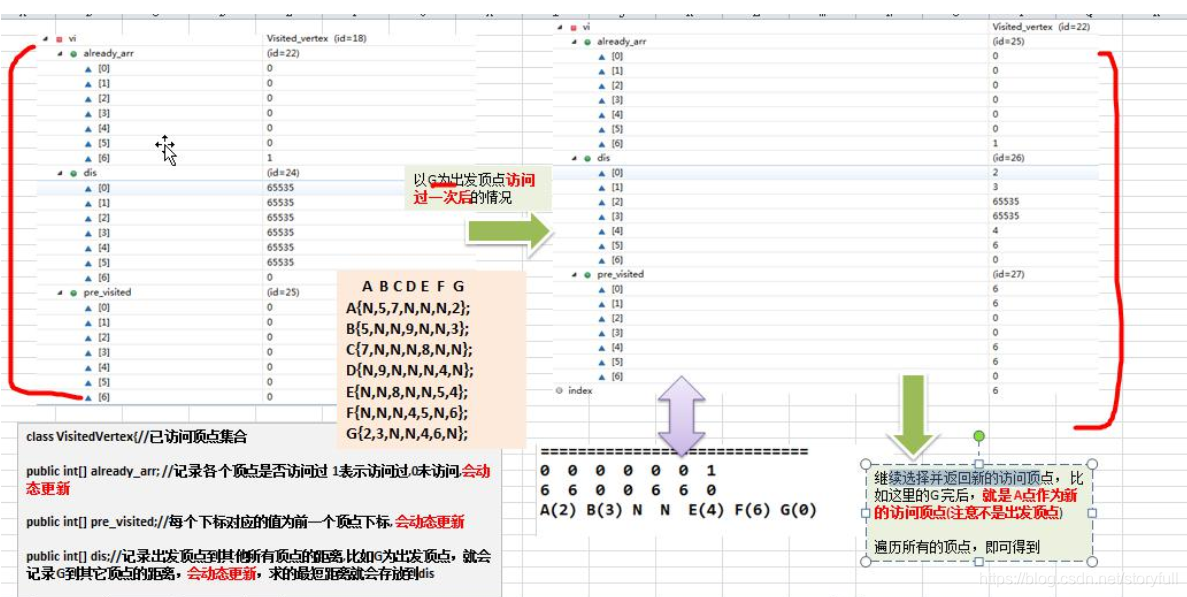基本概述
-
应用场景:

(1)分析一下,虽然还是求最短路径,但是是到各个点的最短路径,假如从G点出发,除了能直接到达的:A、B、E、F,如果要到达D点就有两种选择:一是GBD,二是GFD,选择出一条最短路径 -
迪杰斯特拉算法介绍:

-
迪杰斯特拉算法过程:


图解

Python实现
# 迪杰斯特拉算法
class VisitedVertex(object):
def __init__(self, length: int, index: int):
"""
:param length: 表示顶点的个数
:param index: 出发顶点对应的下标,比如G顶点,下标就是6
"""
self.index = index # 传入的顶点序号,打印时需要用到
self.ver = None # 为了便于打印顶点封装一个对象
# 记录各个顶点是否访问过 1表示访问过,0表示未访问过,会动态更新
self.already_array = [0] * length
# 每个下标对应的值为前一个顶点的下标,会动态更新
self.pre_visited = [0] * length
# 记录出发顶点到其他所有顶点的距离,比如G为出发点,就记录G到其他顶点的距离,会动态更新,求的最短距离会存放在dis
# 初始化 dis数组
self.dis = [float('inf')] * length
# 设置出发顶点被访问过为1
self.already_array[index] = 1
# 设置出发顶点的访问距离为0
self.dis[index] = 0
def is_visited(self, index: int):
"""
判断index顶点是否被访问过
:param index: 传入的顶点
:return: 如果访问过,就返回True,否则返回False
"""
return self.already_array[index] == 1
def update_dis(self, index: int, length: int):
"""
更新出发顶点到index顶点的距离
:param index: 传入的index
:param length: 传入的length
:return:
"""
self.dis[index] = length
def update_pre(self, pre: int, index: int):
"""
更新顶点的前驱为index结点
:param pre:
:param index:
:return:
"""
self.pre_visited[pre] = index
def get_dis(self, index: int):
"""
返回出发顶点到index顶点的距离
:param index:
:return:
"""
return self.dis[index]
# 继续选择并返回新的访问顶点,比如这里的G完后,就是A点作为新的访问顶点(注意不是出发顶点)
def update_arr(self):
min_val = float('inf')
index = 0
for i in range(len(self.already_array)):
if self.already_array[i] == 0 and self.dis[i] < min_val:
min_val = self.dis[i]
index = i
# 更新 index 顶点被访问过
self.already_array[index] = 1
return index
# 显示最后的结果,即将三个数组的情况输出
def show_result(self):
print('===================')
# 输出already_array
for item in self.already_array:
print(item, end=' ')
print()
# 输出pre_visited
for item in self.pre_visited:
print(item, end=' ')
print()
# 输出dis
for item in self.dis:
print(item, end=' ')
print()
# 为了好看最后的最短距离,处理一下
self.ver = Graph(vertex, matrix)
count: int = 0
for item in self.dis:
if item != float('inf'):
print('{}到{}的最短距离为{}'.format(self.ver.vertex[self.index],self.ver.vertex[count],self.dis[count]))
count += 1
print()
class Graph(object):
def __init__(self, vertex: [], matrix: []):
self.vertex = vertex # 传入顶点数组
self.matrix = matrix # 传入邻接矩阵
self.vv = None # 已经访问顶点的集合
def show_djs(self):
self.vv.show_result()
def show_graph(self): # 显示图
for col in self.matrix:
print(col)
# 迪杰斯特拉算法实现
def djs(self, index: int):
self.vv = VisitedVertex(len(self.vertex), index)
self.update(index) # 更新index下标顶点到周围顶点的距离和前驱结点
for j in range(1, len(self.vertex)):
index = self.vv.update_arr() # 选择并返回新的访问顶点
self.update(index) # 更新index下标顶点到周围顶点的距离和前驱结点
# 更新index下标顶点到周围顶点的距离和周围顶点的前驱顶点
def update(self, index):
length: int = 0
# 根据遍历邻接矩阵的 matrix[index]
for j in range(len(self.matrix[index])):
# length 含义:出发顶点到index顶点的距离+从index顶点到j顶点的距离的和
length = self.vv.get_dis(index) + self.matrix[index][j]
# 如果j顶点没有被访问过,并且length小于出发顶点到j顶点的距离,就需要更新
if not self.vv.is_visited(j) and length < self.vv.get_dis(j):
self.vv.update_pre(j, index) # 更新j顶点的前驱为index顶点
self.vv.update_dis(j, length) # 更新出发顶点到j顶点的距离
if __name__ == '__main__':
# 顶点
vertex: [] = ['A', 'B', 'C', 'D', 'E', 'F', 'G']
# 邻接矩阵
matrix: [] = [[0 for col in range(len(vertex))] for row in range(len(vertex))]
# 用来表示一个极大的数
F: float = float('inf')
matrix[0] = [F, 5, 7, F, F, F, 2]
matrix[1] = [5, F, F, 9, F, F, 3]
matrix[2] = [7, F, F, F, 8, F, F]
matrix[3] = [F, 9, F, F, F, 4, F]
matrix[4] = [F, F, 8, F, F, 5, 4]
matrix[5] = [F, F, F, 4, 5, F, 6]
matrix[6] = [2, 3, F, F, 4, 6, F]
# 创建Graph对象
g = Graph(vertex, matrix)
g.show_graph()
# 测试迪杰斯特拉算法
g.djs(6)
g.show_djs()
''' 输出结果
[inf, 5, 7, inf, inf, inf, 2]
[5, inf, inf, 9, inf, inf, 3]
[7, inf, inf, inf, 8, inf, inf]
[inf, 9, inf, inf, inf, 4, inf]
[inf, inf, 8, inf, inf, 5, 4]
[inf, inf, inf, 4, 5, inf, 6]
[2, 3, inf, inf, 4, 6, inf]
===================
1 1 1 1 1 1 1
6 6 0 5 6 6 0
2 3 9 10 4 6 0
G到A的最短距离为2
G到B的最短距离为3
G到C的最短距离为9
G到D的最短距离为10
G到E的最短距离为4
G到F的最短距离为6
G到G的最短距离为0
'''
